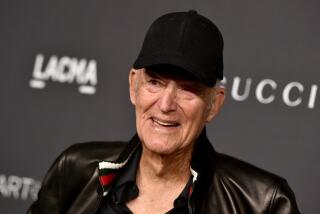Chihuly’s tapestry of glass
- Share via
CORAL GABLES, FLA. — A starburst of yellow glass cones hanging from an oak tree makes an unlikely forest chandelier. Red reeds rise from the cactus garden. And where the macaws fly low, the pink crags are piled like a massive tower of rock candy.
Dale Chihuly’s work has transformed the Fairchild Tropical Botanic Garden, adding spheres of multicolored glass to ponds where lily pads once floated alone, and kaleidoscopic columns to patches of green. The reach of the world’s premier glassblower extends far beyond the cycads and palms of pretty Coral Gables, though, to the Louvre and the Metropolitan Museum of Art, to Jerusalem and to Seoul.
And before Fairchild, Chihuly showed his creations at the New York Botanical Garden in the Bronx and the Missouri Botanical Garden in St. Louis.
Like Louis Comfort Tiffany and Rene Lalique before him, Chihuly has helped elevate what often is thought simply as a craft to a fine art and captivated millions who’ve seen his work. Count among them Bruce Greer, president of the board of trustees at Fairchild, who was instrumental in bringing Chihuly’s work here two years in a row.
“The predominant word, from intellectuals to children is the same: ‘Wow,’ ” Greer said.
Sixty-five, with paint-splattered shoes, a bush of curly hair and a black patch over his left eye, Chihuly (pronounced chuh-HOO-lee) was born in Tacoma, Wash., to a butcher-turned-union organizer father and homemaker mother.
As a teenager, he lost his father to a heart attack and his brother to a Navy plane crash. He was depressed but reluctantly enrolled in college at his mother’s insistence.
He had decided to pursue a life in interior design and architecture, but learned to melt glass and did some innovative work incorporating it into woven tapestries. He was in his mid-20s and had never seen glass blown when he first picked up a pipe and tried it.
“I’m just amazed that there was this bubble at the end of the pipe,” he said from his Seattle studio. “From that point on, I wanted to be a glassblower.”
In four decades since, he has regenerated the artistic view of glass more than anyone else since Tiffany garnered attention with stained-glass windows and lamps a century ago. He has shattered what the public thought possible with the medium, building bigger, more complex pieces than ever before.
“Tiffany made large stained-glass windows, but Chihuly does these huge installation pieces that become architectural in a different way -- very sculptural installations,” said David Revere McFadden, chief curator at the Museum of Arts & Design in New York. “Chihuly’s sense of the theatrical is much more dramatic.”
Chihuly’s assessment of his work is simple: “I like to make things that nobody’s seen.”
The artist’s love of glass led him to Alaska as a young man, where he worked as a fisherman to make enough money to study glassblowing at the University of Wisconsin at Madison. He won a Fulbright scholarship, which allowed him to travel the globe and shadow the world’s masters of glass. Chihuly established programs teaching glass art to others and has pulled off incredible exhibitions and installations in hundreds of museums and private collections.
But glass also nearly ended Chihuly’s life and forever altered the way he works.
In 1976, while driving in England with painter friend Seaver Leslie, Chihuly was in a head-on collision as the pair approached a rotary intersection in the countryside west of London. He spent weeks in the hospital and received 256 stitches in his face. He lost his left eye and nearly lost his right one.
The vision that remained lacked depth perception, complicating his already delicate work, but Chihuly says he has not dwelled on the accident.
“It was never a sad thing for me,” he said. “I felt so lucky that I ended up with one eye because I was very close to losing the other one, and I could have been killed very easily.”
Chihuly was able to continue blowing glass for a few years, but dislocated his shoulder while bodysurfing in 1979 and had to give up the gaffer job, as the lead glassblower is known. He since has led others in a symphony of work to realize his artistic visions.
Nearly 100 people work for him today, helping create intricate pieces such as “The Sun,” the massive collection of orange and yellow coils rising from the Fairchild grounds until the exhibition closes May 31.
More to Read
The biggest entertainment stories
Get our big stories about Hollywood, film, television, music, arts, culture and more right in your inbox as soon as they publish.
You may occasionally receive promotional content from the Los Angeles Times.










